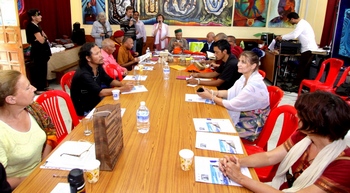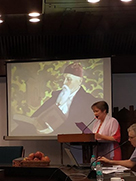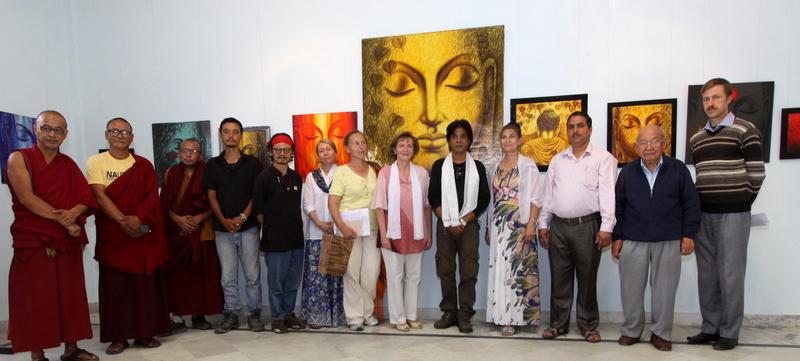On August 16, 2018, the International Roerich Memorial Trust (IRMT) held a programme on the occasion of the 116th anniversary of George Roerich, the elder son of Nicholas and Helena Roerich, and the renowned orientalist, linguist, Tibetan Buddhist scholar, archeologist and explorer of Central Asia.
In accordance with what has become an established and good tradition, on that day the IRMT invited Buddhist scholars and lamas. The programme started with Lama Choepa, the Tibetan analogue of Guru Puja, the ceremony for the posthumous well-being of one’s spiritual master. The ceremony was conducted by the lamas of the Badah Gompa and Pangang Gompa in the IRMT Conference Hall and was attended by the guests from India, Russia, Great Britain and France.
On the completion of the ceremony, in the same hall was inaugurated the painting exhibition by the Tibetan artist Karma Sichoe, a Dharamsala-based thangka painter and artist. In the exhibition titled “The Quest” he displayed several of his works which he describes as self-portraits that express his vision and exploration of his inner self. His works, inspired by Buddhist philosophy and imagery, reflect the hard way of spiritual transformation and continuous struggle with kleshas, the mental obstacles to liberation. Being a thangka painter (the tradition of Buddhist painting on fabric), Mr. Sichoe also displayed the holy images of Bodhisattva Manjushri and Green Tara.
From the exhibition reflecting the problems connected with winning a victory over oneself, the guests proceeded to the Exhibition Hall to see the exhibition of paintings unfused with the feeling of peace, tranquility, balance and harmony. “Lord Buddha” – such was the laconic name that the Delhi-based artist Prince Chand who exhibited his works in the IRMT more than once, gave to his art show. Mr. Chand has been exploring the image of the Buddha for more than 25 years studying canonical Buddhist texts and reflecting on them. “To me, the Buddha’s main message is that of peace. The peace within and the peace without,” explains Mr. Chand while showing the collection of his Buddha images done in a wide range of colours. In the case of Mr. Chand, the image of the Buddha has proven an inexhaustible source of inspiration, both aesthetic and philosophical.
|  |
| |
The central part of the programme was the academic seminar “George Roerich’s Tibetology Research” which brought together several Indian, Russian and Tibetan scholars. It was chaired by the Tibetan and Buddhist scholar from Lahaul Mr. Tsering Dorje who personally knew George Roerich and assisted him in his studies of the Tibetan dialect of Lahaul. Last year, on the initiative of Tsering Dorje and with the support of the State Government of Himachal Pradesh, the studio of Nicholas Roerich where this great Russian artist painted during the summer seasons in early 1930s was reconstructed and opened for visitors.
On behalf of the staff of the International Roerich Memorial Trust the guests and participants of the seminar were welcomed by the representative of the IRMT management Amarjeet Anand and the Russian Curator Larisa Surgina. Being an employee of the International Centre of the Roerichs (ICR), Moscow, Mrs. Surgina wished the participants of the seminar all success on behalf of the ICR staff. She familiarized the gathering with the life and achievements of the Roerichs, which became possible due to their close cooperation with the spiritual Masters of the East, and stressed that the ideas of the Living Ethics or Agni Yoga, the philosophical teaching talking of the cosmic evolution of mankind, was the basis of the life and creative work of George Roerich, as well as his parents and younger brother. It were these ideas that decided the direction of his activities as a scholar and the continuous director of ‘Urusvati’ Himalayan Research Institute.
The participants of the seminar got a rare opportunity to have a look at some of the unique collections of ‘Urusvati’ Institute preserved in the IRMT. They carefully browsed the Tibetan manuscripts that included the biography and works of the outstanding Tibetan lama scholar Pema Karpo, the biography of the famous Tibetan yogi and poet Milarepa, the illuminated manuscript on Tibetan medicine, and the Kalachakra Tantra; went through the original editions of the volumes of the Tibetica Series launched by George Roerich and dedicated to the antiquities of Tibet; familiarized themselves with the rare magazines from the memorial library of the Institute; and perused the handwritten copy of the Tibetan epic of Gessar Khan made on the order of George Roerich. The glass bottles containing samples of Tibetan medicinal plants and minerals with labels filled with handwritten Tibetan inscriptions made in 1930s by the traditional Tibetan medicine men, or amchis, excited particular interest of the guests, along with the fossils (ammonites, belemnites) collected during the Institute’s field work in the Himalayan region.
Mrs. Tatyana Mironyuk, a pulmonologist from Archangelsk (Russia) presented a paper on the “Main Areas of Research of ‘Urusvati’ Himalayan Research Institute and its Director George Roerich.” Mrs. Mironyuk dwelled on the methodology of the Institute which consisted in the synthesis of the spiritual and experimental ways of knowing and a combination of the ancient knowledge of the East and the achievements of the contemporary science of the West. She spoke on the structure of the Institute, its connections with the academic circles the world over and its active exploration of the Western Himalayan and Western Tibetan region.
The Institute and its director George Roerich actively cooperated with the scholars from the Himalayan region. One of such collaborators was the renowned Tibetan linguist, writer and explorer Gendun Chophel. To him and his friendship and cooperation with George Roerich was dedicated the paper by Tenzin Tsundue, the Tibetan writer from Dharamsala. For two years, supposedly in early 1940s, Gendun Chophel lived in Naggar on the invitation of George Roerich assisting him in the translation from Tibetan of the Blue Annals (15th century), the chronicle of the spread of Buddhism in Tibet. He quoted the letter of Gendun Chophel addressed to George Roerich where the Tibetan scholar calls George Roerich “Dharma friend.” Tenzin Tsundue stressed that the contribution that Gendun Chophel and George Roerich made to the world culture and their own national cultures was astounding. Both possessed the unquenchable thirst for knowledge, studied languages, and translated ancient texts. Both passed away comparatively early. And both, having spent most of their life abroad, remained true patriots.
It is worthy of note that George Roerich’s English translation of the Blue Annals was published in 1949 and became one of the most authoritative sources on the history of Tibetan Buddhism. In the preface, George Roerich expresses his sincere gratitude to the “renowned Tibetan scholar” Gendun Chophel for his help in translating the text.
The next speaker, Lama Ngawang Rigzin from the Badah Gompa, Kullu, presented a paper on the “Six Yogas of Naropa.” This tradition was studied by George Roerich in the Kardang monastery during the ‘Urusvati’ Institute’s fieldwork in Lahaul in early 1930s. Introducing the paper, Mr. Tsering Dorje remarked that he had learnt about it from the Kardang monastery lamas – the disciples of Lama Norbu, the renowned practitioner of this system with whom George Roerich was in direct contact. Lama Ngawang Rigzin represents the tradition of the six yogas of Naropa brought to Lahaul by the Lamas Norbu and Kunga. In 1960s, he had spent four years in Gungshel village, Lahaul where in 1930s the summer station of ‘Urusvati’ Institute was located, and heard about the Roerichs and their activities. Subsequently he was a lama in the Kardang monastery. Lama Rigzin told the gathering about the journey of Lama Norbu and Lama Kunga to Tibet, their studies under the well-known yogi Shakyashiri, and their subsequent return to Lahaul (where George Roerich interacted with them), and their activities for the promotion of this yogic system in the Western Himalayan region.
The Six Yogas of Nāropa are a set of advanced Tibetan practices intended to help in the attainment of Buddhahood. They are meant to help maintain clarity of mind at all times no matter the state of body and mind. The speaker told about one of the yogas of Naropa, the yoga of inner heat (tummo). The Buddhists practicing this yoga should be able to “radiate” heat and be totally insensitive to cold. Lama Rigzin said that during the exam held in the winter season at night the practitioner should wrap himself in a cloth drenched in cold water and dry it with his body heat repeating this cycle upto 12 times.
Commenting on the paper, Mr. Tsering Dorje noted the relevance of this practice at present especially for the army, which has to face winter cold in high altitude areas. He mentioned that he had even approached the state government with the proposal to impart this technique to army personnel.
 | |
| |
Tibetan medicine and the medicinal herbs and minerals used in it was the major research area of ‘Urusvati’ Himalayan Research Institute. The Roerichs experimented with growing high altitude plants, and several traditional Tibetan doctors, including some from Lahaul, were invited to the Institute to develop a collection of the samples of medicinal herbs. The Institute studied the means to cure cancer, and George Roerich paid particular attention to Tibetan medicine in this context. In this regard, the paper by the traditional Tibetan doctor (amchi) Norbu from Kullu was of special interest. He said that the traditional Tibetan medicine was called Sowa Rigpa, which can be translated as “saving knowledge” or “knowledge for saving.” The tradition is three to four thousand years old including two thousand years of written history. Till 1960s-70s save for the amchis there were no other doctors in Lahaul. With the arrival of modern medicine on the stage, the traditional medicine did not lose its significance. The amchi community of Lahaul in its officially recognized form is closely associated with the name of the renowned amchi Sundar Singh who studied in Tibet and subsequently opened a medical institute in Manali where many students from various Himalayan regions studied traditional medicine.
The speaker remarked that traditional medicine was finding it more and more difficult to compete with modern medicine and pharmaceutical industry. Nevertheless, certain diseases like Parkinson disease, multiple sclerosis, arthritis, etc. have no cure in modern medicine, and the medicines used to cure them have long-term side effects. In such cases, claimed the doctor addressing first of all the Russian part of the audience, it makes sense to approach Tibetan doctors. The Tibetan Medical Astrological Institute (Men-Tsee-Khang) in Dharamsala is studying and developing previously unknown medical methods, and Tibetan medicine can successfully tackle many cases of the above mentioned diseases.
Nevertheless, noted amchi Norbu, in the field of diagnostics, for instance, Tibetan doctors should make use of modern medicine and technology. In other words, there is a need for close cooperation between Sowa Rigpa, Ayurveda, yoga and modern medicine.
The speaker dwelled on the wealth of the medicinal flora of the West Himalayan region. There are around 250–300 medicinal herbs found in the area of Rohtang Pass, in Lahaul and Spiti, and most of them he can identify.
In conclusion, on the request of the chairman of the seminar and the IRMT curator, amchi Norbu agreed to help in the identification of the ‘Urusvati’ Institute medical collection.
Dr. Tashi Paljor, former director of the Central Institute of Buddhist Studies, Leh, greeted the participants of the seminar and remarked that India and Russia had been old and time-tested friends. He said that the multifaceted activities of the Roerichs in Western Himalayan region were truly unique, and highly appreciated the achievements of George Roerich as Buddhist scholar and researcher in Tibetan literature, noting that he managed to gain profound understanding of Buddhism, its history, philosophy and art. “The fact that a foreign scholar studied Kalachakra or Tantra is very inspiring for us. To study Kalachakra Tantra one should have karuna (сompassion), maitri (loving-kindness), and realization of emptiness,” explained Dr. Paljor. He also mentioned about George Roerich’s cooperation with Gendun Chophel and noted that while staying in Naggar the latter for the first time translated into Tibetan from the original Pali the collection of the Buddha’s aphorisms, the Dhammapada (in 1960, George Roerich would become the editor of the Russian translation of the Dhammapada made from Pali by V.N.Toporov). Dr. Tashi Paljor also donated to the ‘Urusvati’ Institute Library several books on the Buddhist philosophy.
Rajeshwar Thakur from Lahaul presented a paper titled “Western Tibetan Expedition of ‘Urusvati’ Himalayan Research Institute.” Rajeshwar is the great grandnephew of Thakur Rup Chand from Kolong, Lahaul, who during the expedition was the main assistant of Dr. Walter Koelz, the botanist and biologist from the Michigan University who cooperated with ‘Urusvati’ Institute in the beginning of 1930s.
In 1931, having started from the Kullu valley and following the ancient trade route the expedition crossed the Rohtang Pass, traversed Lahaul, explored the Tso Moriri lake area, crossed the Baralacha Pass and entered Ladakh. The Institute staff studied the rich flora and fauna of the region and the migrations of the gaddis, the local nomadic communities, and built a significant collection of the samples of Himalayan plants and birds. The speaker talked in some detail about the history of the expedition, its route, its interaction with the respected members of the local communities, and its research activities.
The next scholar to take floor was Sonam Tsering Shastri, the researcher in the folk songs of Lahaul. His paper was on George Roerich’s studies of Lahauli folk songs. George Roerich made a significant contribution to the studies of Lahauli language and oral folk tradition. For instance, he collected, translated and studied the old songs performed during certain ceremonies in that region. The results of his studies were published in the Journal of ‘Urusvati’ Himalayan Research Institute (vol. III, 1932) as part of his monograph The Tibetan Dialect of Lahaul. Mr. Sonam Shastri dwelled on the two of these songs touching on their content and the context of their performance, and even sang several fragments. Solemnly flowed the lines of the ancient songs steeped in age-old wisdom:
“In the blessed kalpa of former times,
a crystal throne was erected.
There who is able to sit?
There sit the happy men.
Hail to the abode of the happy men!”
The seminar closed with the paper by the chairman, Tsering Dorje, titled “George Roerich’s Description of the Kalachakra Tantra.” (Kalachakra is the Sanskrit for the ‘wheel of time’). Tsering Dorje is a renowned scholar of the life and work of the Roerichs and an old friend of the IRMT. He started his paper with quoting from the article by George Roerich Studies in the Kalachakra published in the Journal of ‘Urusvati’ Himalayan Research Institute (vol. II, 1931) and noted that George Roerich was probably the first Western scholar who studied in detail this extremely difficult text, its tradition and references to it in Tibetan sources. Not everyone can understand this text. Its studies are made more difficult by the fact that it uses a highly coded language whose understanding requires the in-depth knowledge of Indian astronomy, astrology and Sanskrit. Kalachakra Tantra is one of the highest Buddhist spiritual traditions. It talks about the structure of man and universe. According to Buddhist sources, this knowledge was imparted by the Buddha to Suchandra, the King of Shambhala, from where it travelled to India, and then to Tibet. Nowadays, Kalachakra initiations take place in various countries, and the knowledge of this system, earlier the exclusive privilege of Tibetans, is spreading far and wide.
In conclusion, the chairman of the seminar Tsering Dorje and the Russian Curator of the IRMT Larisa Surgina thanked the delegates for presenting such interesting papers and expressed their hope for future cooperation with them. The Russian Curator expressed her special gratitude to Tsering Dorje for his valuable help in organizing the event.
The programme ended with the slide show on “The Roerichs in Ladakh” presented by the ICR and IRMT employee Alexander Pereverzev. The presentation made use of the photographs taken by the Roerichs during their Central Asian Expedition, paintings by Nicholas Roerich and excerpts from expedition diaries (Altai-Himalaya by Nicholas Roerich and Trails to Inmost Asia by George Roerich). “I still cherish in my memory the picture of this ancient corner of westernmost Tibet,” wrote George Roerich for whom Ladakh was important in the context of his Tibetology research. It is not accidental that Ladakh was called Little Tibet. “For the history of Buddhism in Tibet this region is of special interest,” wrote George Roerich, “It is a known fact that the Indian pandits who brought the Buddha’s teaching to Tibet in the 7th century A.D. entered that country from the West... Here, in the West Himalayas one can find plenty of Tibetan Buddhist holy places associated with the first preachers of the Buddhist creed in Tibet.” It was in Ladakh proper, as was noted by George Roerich, that many Western Tibetan scholars had their first brush with Tibetan culture.
The programme of the day was quite rich and ended only late in the evening. One can claim with certainty that it became one more step towards the revival of ‘Urusvati’ Institute of Himalayan Studies whose director was George Roerich.

































